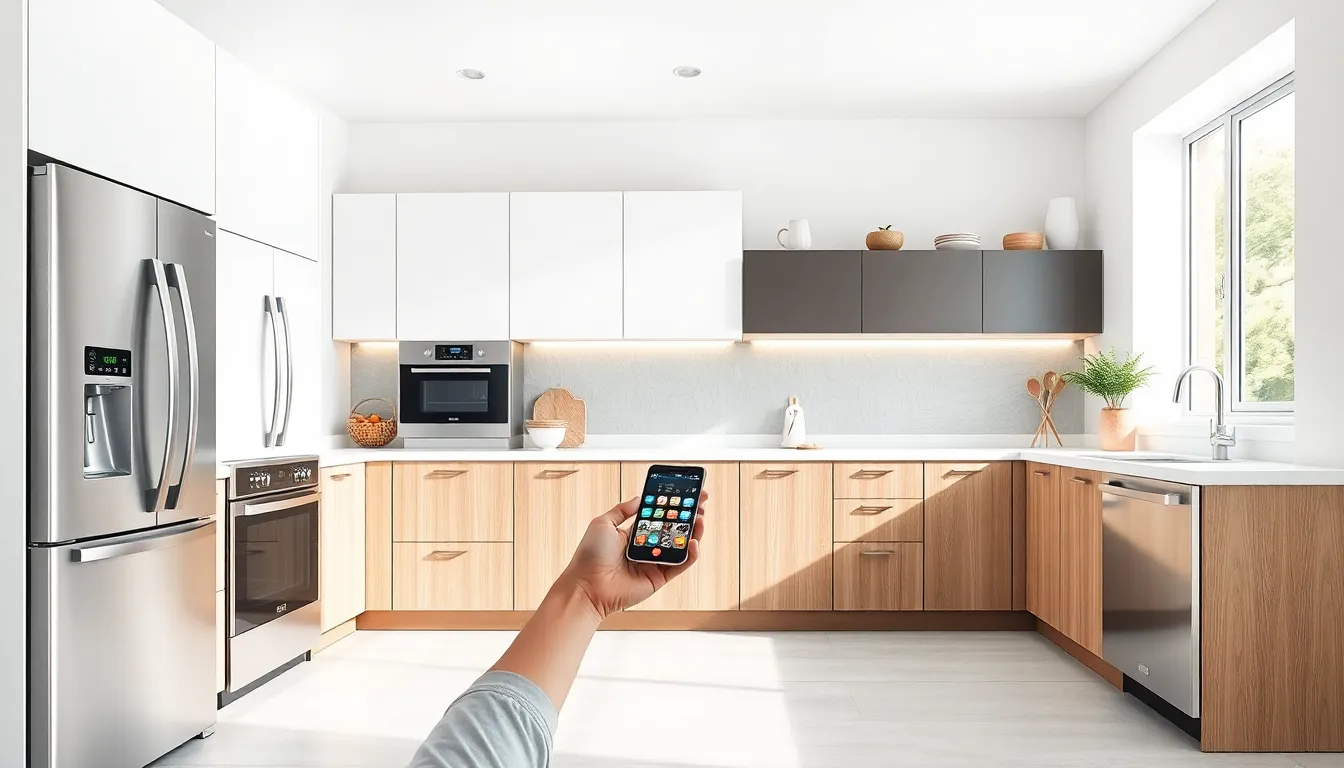In today’s fast-paced world, a smart kitchen can transform everyday cooking into a seamless experience. With the rise of technology, homeowners are discovering innovative ways to enhance their culinary spaces. From voice-activated assistants to smart appliances, a well-equipped kitchen not only saves time but also elevates the joy of cooking.
Setting up a smart kitchen involves more than just purchasing gadgets. It’s about creating an integrated ecosystem that simplifies tasks and streamlines meal preparation. By embracing smart technology, individuals can enjoy greater convenience, efficiency, and even sustainability in their cooking routines. This guide will explore essential tips and tools for transforming any kitchen into a smart, connected hub.
Table of Contents
ToggleUnderstanding Smart Kitchens
Smart kitchens leverage technology to enhance cooking efficiency and convenience. They integrate various devices and systems that communicate seamlessly. Voice-activated assistants, such as Google Assistant and Amazon Alexa, allow for hands-free operation, enabling users to control appliances, set timers, and access recipes effortlessly.
Smart appliances, including refrigerators, ovens, and dishwashers, connect to Wi-Fi, enabling remote management. For example, a smart refrigerator can notify users of contents, suggest recipes based on available ingredients, and monitor expiration dates. Smart ovens, capable of adjusting cooking times and temperatures, enhance precision in meal preparation.
Energy efficiency plays a crucial role in smart kitchens. Smart devices often come equipped with features that optimize energy usage. For instance, smart thermostats automatically adjust the temperature based on cooking activities.
Additionally, smart kitchens support sustainability. They facilitate meal planning and grocery inventory management, reducing food waste. Integration with shopping apps allows users to order groceries directly, minimizing trips to the store.
Creating a smart kitchen involves thoughtful selection and integration of devices. Choosing compatible devices enhances functionality. Prioritize options that support existing systems and services to ensure a streamlined user experience.
Key Components of a Smart Kitchen

A smart kitchen relies on specific components that enhance user experience and efficiency. These elements integrate seamlessly to provide a modern cooking environment.
Smart Appliances
Smart appliances play a significant role in streamlining kitchen tasks. These devices, including refrigerators, ovens, and dishwashers, connect to Wi-Fi, enabling remote monitoring and control.
- Smart Refrigerators: Monitor food inventory and notify users when items run low. They may provide recipe suggestions based on available ingredients.
- Smart Ovens: Adjust cooking temperatures and times based on specific recipes. Some models feature built-in cameras for real-time food monitoring.
- Smart Dishwashers: Offer cycle notifications and energy-efficient cleaning options based on the load size.
These appliances enhance convenience and help manage kitchen tasks efficiently.
Connectivity Features
Connectivity features maximize the functionality of a smart kitchen. They ensure all devices work harmoniously and can be controlled from anywhere.
- Wi-Fi & Bluetooth: Enable communication between devices for synchronized operation. Smart assistants can control appliances via voice commands.
- Mobile Apps: Provide control over devices remotely, allowing users to manage cooking schedules and monitor energy use from smartphones.
- Integration with Smart Home Systems: Connects kitchen devices with the broader smart home ecosystem, enhancing automation capabilities.
These connectivity features create a cohesive smart kitchen environment, simplifying meal preparation and enhancing overall efficiency.
Benefits of Setting Up a Smart Kitchen
Setting up a smart kitchen offers significant advantages, primarily in efficiency and the overall cooking experience. Integrating technology into kitchen operations not only simplifies tasks but also enhances the joy of cooking.
Increased Efficiency
Increased efficiency defines a smart kitchen’s core advantage. Smart appliances streamline various tasks by automating processes.
- Smart refrigerators track food inventory, ensuring users know what ingredients are available.
- Smart ovens adjust cooking times and temperatures automatically based on recipe requirements.
- Smart dishwashers send cycle notifications, freeing up time for other tasks.
These features minimize manual input and reduce the risk of errors during cooking. Voice-activated assistants enable hands-free management, allowing for multitasking without disruption. Consequently, less time spent on meal prep leads to a more organized and enjoyable cooking routine.
Enhanced Cooking Experience
Enhanced cooking experience shapes how users engage with their culinary activities. With smart technology, cooking transforms from a chore into a delightful activity.
- Intuitive interfaces guide users through intricate recipes, facilitating experimentation and creativity.
- Connected devices share cooking tips, provide step-by-step instructions, and even adjust ingredient quantities based on servings.
- Seamless integration with smart home systems allows users to create personalized cooking environments.
Additionally, real-time feedback from devices helps improve cooking skills over time. As a result, individuals gain confidence in their abilities, enriching their culinary journey.
Steps to Setup a Smart Kitchen
Setting up a smart kitchen involves careful planning and selection of devices that enhance functionality. Following key steps leads to an efficient and cohesive cooking environment.
Assessing Your Needs
Assessing needs involves identifying specific cooking tasks and lifestyle preferences. He or she should evaluate current cooking habits and frequency of meal preparation. Consider factors such as family size, dietary requirements, and available kitchen space. Determine which tasks, like inventory management or recipe suggestions, would benefit from automation. Identifying these factors ensures the smart kitchen meets personal preferences for convenience and efficiency.
Choosing the Right Devices
Choosing the right devices requires careful consideration of features and compatibility. Research various smart appliances, including refrigerators, ovens, and dishwashers, to find options that fit specific needs. Look for devices that offer features such as remote control, energy management, and integration capabilities. Prioritize brands known for reliability and quality. It’s essential to select devices that communicate seamlessly with each other and existing smart home systems, enhancing overall functionality.
Installation and Configuration
Installation and configuration consist of setting up the kitchen environment effectively. Start by placing devices in optimal locations for accessibility and functionality. Follow manufacturer instructions for connecting each appliance to Wi-Fi and ensuring proper configuration through mobile apps. Customize settings based on personal preferences, such as cooking modes and inventory notifications. Test device connectivity and functionality before relying on them for daily tasks to ensure an integrated cooking experience.
Embracing the smart kitchen revolution can significantly elevate the cooking experience. By integrating technology thoughtfully, individuals can enjoy a more efficient and enjoyable kitchen environment. The convenience of smart appliances not only streamlines meal preparation but also encourages sustainable practices.
With the right devices in place, cooking can transform from a chore into a delightful activity. The seamless connectivity and automation allow for better multitasking and organization. As technology continues to advance, the potential for innovation in the kitchen is limitless. Investing time and effort into setting up a smart kitchen will undoubtedly pay off in enhanced culinary adventures and a more connected home.




